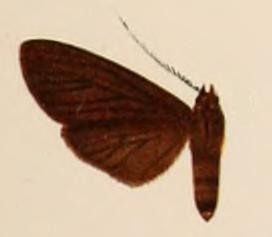
Nyctemera is a genus of tiger moths in the family Erebidae first described by Jacob Hübner in 1820. The genus includes the species Nyctemera annulata and Nyctemera amica, which are closely related and are able to interbreed.

Utetheisa is a genus of tiger moths in the family Erebidae. The genus was first described by Jacob Hübner in 1819.

Aemene is a genus of moths in the family Erebidae first described by Francis Walker in 1854. They are found in Japan, throughout India and Sri Lanka.
Capissa is a monotypic tiger moth genus in the family Erebidae. It was previously treated as a synonym of Eilema. Its only species, Capissa vagesa, is found in the north-western Himalayas, Kashmir, Nepal and Upper Myanmar. Both the genus and species were first described by Frederic Moore; the genus in 1878 and the species in 1860.

Creatonotos is a genus of tiger moths in the family Erebidae. The moths in the genus are found in the Afrotropics, South and East Asia, Sundaland and Australia.

Digama is a genus of moths in the family Erebidae described by Frederic Moore in 1858. It is distributed in South Africa, China, throughout India, Sri Lanka, Myanmar and Australia.
Gampola is a genus of moths in the family Arctiidae. They were found from Sri Lanka, where the generic name is due to the Gampola area of Kandy, where the first species was discovered. In June 2016, another species was found from India and other few nearby countries such as China, Hong Kong, and Thailand.

Miltochrista is a genus of moths of the family Erebidae, subfamily Arctiinae. The genus was erected by Jacob Hübner in 1819.

Nudaria is a genus of moths in the subfamily Arctiinae erected by Adrian Hardy Haworth in 1809.

Oeonistis is a genus of moths in the family Erebidae first described by Jacob Hübner in 1819. They are found in India, Sri Lanka, Myanmar, Borneo and other minor islands of Oceania.

Pelochyta is a genus of moths in the family Erebidae. The species was first described by Jacob Hübner in 1819. They are distributed in Africa, throughout India, Myanmar, Sri Lanka, Australia and New Britain.

Thumatha is a genus of moths in the family Erebidae. The genus was erected by Francis Walker in 1866. Species are distributed in the Oriental and Australian regions.

Asota is a genus of moths in the family Erebidae first described by Jacob Hübner in 1819. Species are widely distributed throughout Africa, India, Sri Lanka, Myanmar, the Malayan region and tropical parts of the Australian region.

Pseudoterpna is a genus of moths in the family Geometridae first described by Jacob Hübner in 1823.

Argina astrea, the crotalaria podborer, is a moth of the family Erebidae. The species was first described by Dru Drury in 1773. It is found in eastern Africa, southern Asia of India, Sri Lanka, and Indo-Australia, including the Pacific Islands and Australia.

The Nyctemerina are a subtribe of woolly bear moths in the family Erebidae.
Juxtarctia is a genus of tiger moths in the family Erebidae. The genus is monotypic, containing only one species, Juxtarctia multiguttata described by Francis Walker in 1855, which is endemic for the Himalayas.

Juxtarctia multiguttata is a polymorphic tiger-moth in the subfamily Arctiinae, endemic for Himalayas. It is known from India: north-west Himalayas, Sikkim, Assam; Nepal; Bhutan; Myanmar; China: Tibet within western slopes of the Himalayas; Indochina.

Mangina is a genus of tiger moths in the family Erebidae.
Lemyra subfascia is a moth of the family Erebidae. It was described by Francis Walker in 1855. It is found in Sri Lanka.















